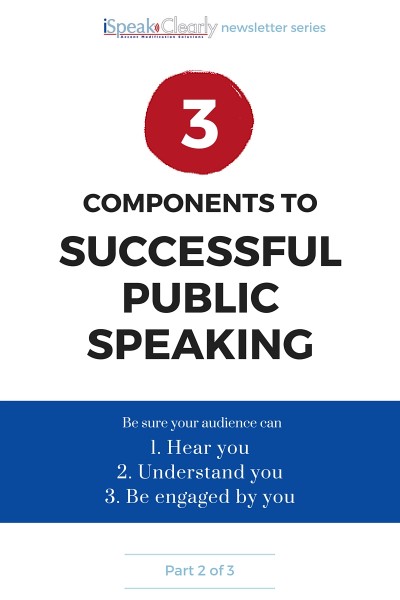This blog post is #1 in a three-part series on Successful Public Speaking. The impression you make as a speaker is based on what you say and how you say it.
When clients come to me, they often know their speaking skills need improvement, but they’re not sure where to begin. I help them become aware of the many interrelated components that make up effective communication, and they’re able to improve their public speaking skills.
I always say, if your audience can (1) hear you, (2) understand you, and (3) become engaged by your enthusiasm, you are on your way to being a successful speaker. For this post, we’ll start with making sure your audience can hear you.
Part 1: Let your voice be heard
The first step in delivering your message successfully is to be sure the audience can hear it.
- Is your voice loud enough?
- Does nervousness undermine your confidence and cause you to speak softly?
- Do you ever get the sense that your message wasn’t received?
If so, a few techniques for better breathing, relaxation, and vocal projection can help your audience hear you during a presentation or speech.
MASTER YOUR BREATHING
Breath is the fundamental component of voice. Air passing between the vocal cords causes them to vibrate, creating the sound that is your voice. Good breathing technique and control are key to generating adequate loudness.
Most of the people I work with have difficulty relating breathing to the loudness of their voice. One day, while working with a client who was speaking about the long-distance migration of insects, I had an “aha” moment.
The wind! Think of your breath as the wind, blowing papers down the road. A gentle breeze will move the paper only a short distance, but a strong, gusty wind will blow that paper down the road. If you want your voice to be heard across the room, you need a strong breath, like the strong wind.
To “blow” your voice across the room, you must support your speech with abdominal or diaphragmatic breathing. The diaphragm is a muscle below the lungs and above the abdomen. When we take a full abdominal breath, our lungs fill to capacity. Then the abdomen protrudes, and we can use our abdominal muscles to control exhalation during speech.
By filling your lungs to capacity, you create a strong, powerful stream of air, which results in a full, pleasing voice with good volume.
RELAXATION
Nervousness undermines our breathing, our voice, and our volume. When we become tense, we restrict the airflow as we inhale and exhale. Before or during a speech, it helps to focus on the good feeling relaxation can bring. You can do this using the tense/relax technique.
The tense/relax technique can be used while you’re waiting for your turn to speak, either sitting or standing. Tense one area of your body (perhaps the toes, hands, or abdomen), hold for 10 seconds, then release. Become aware of the contrast between tension and relaxation.
Clients sometimes say this is too much to think about while they’re trying to focus on what they want to say. So I encourage you to keep it simple. When you feel that tightness in your belly that comes with nerves, release it.
Not only will it have a calming effect, it will allow airflow to resume. (We often hold and restrict our breath in tense situations without even realizing it.) The lungs will have the room to fill to capacity, and you will have adequate breath for speech and feel more relaxed at the same time. It’s a win-win.
VOICE PROJECTION
Voice projection is a crucial component in any speaking situation, whether one-to-one, with a small group, on the phone, or in front of a large audience. When we are nervous or unsure of ourselves, we often allow our voice to stay in the area of the mouth and lips. But when we project our voice, we move it from our mouth area to the location of the listener.
How well we project our voice is directly related to breath support and control. You must create a strong flow of air (like the wind, as mentioned earlier) that will carry your voice to the listener.
Think about the type of “wind” you need. Are you speaking across the conference table, or across the room?
To project your voice, square your shoulders to the listener(s) and direct your mouth (and your voice) to them. Imagine your words on that piece of paper I referred to earlier, and generate the breath that will carry the paper (your voice) to them.
Your listener will hear you, and you will convey confidence in what you say.
Put these techniques to use during your next presentation
When you (1) master your breathing, (2) control your nervousness through relaxation, and (3) project your voice to the listener, your voice will be heard, and you will be perceived as confident.
Spend some time practicing these techniques before your next presentation. Decide if they worked for you, or if you need a little more practice. Then send me an email
to let me know how it went!
Watch for Parts 2 and 3 of this series on Successful Public Speaking
The next steps to successful public speaking are to ensure that your message will be understood and to engage your listener. Watch for the upcoming newsletters, where I will discuss these topics in more detail.




